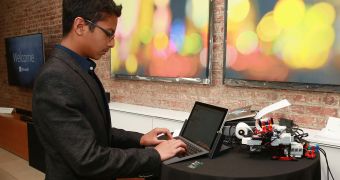Microsoft is working with a 13-year-old entrepreneur to integrate drivers for a low-cost Braille printer in Windows 10, thus trying to improve life for those who are visually impaired.
Shubham Banerjee was only 12 when he created his very first Braille printer from Lego and working with Windows and a Surface Pro 3. He then posted instructions on how to build this device on the Internet and provided guidance to anyone who wanted to create an affordable Braille printer for as low as $350 (€300).
“I discovered that typical Braille printers cost about $2,000 or even more, and I felt that was unnecessarily expensive for someone already at a disadvantage,” Shubham said. “So I put my brain to work, and the first thing that came to mind was to create an alternative using my favorite toy.”
He called his first printer Braigo (a mix of Braille and Lego) and he has recently created an upgraded model that would come as a consumer-ready version that can be used by anyone with Windows.
Microsoft jumps in to help
Called Braigo 2.0, the new printer uses Intel's Edison Chip and will be supported natively in Windows, as Microsoft has started working together with the student to integrate drivers for the new device in its operating system.
The device is not yet available, but it should become soon, Microsoft says, as his company, Braigo Labs, has recently received venture capital funding from Intel Capital.
“Think about the banks, the government institutions or even the libraries where Windows-based computers are widely used. They will all benefit from having a Braigo to provide accessibility services to their visually impaired customers,” Banerjee pointed out.
Needless to say, Microsoft used this occasion to praise the potential of the IoT industry, explaining that, with the right tools and software, anyone can create devices that could change the world. Windows 10 would also come with a stand-alone SKU for IoT devices, so Microsoft too is supporting the evolution of this new, rapidly growing side of the industry.

 14 DAY TRIAL //
14 DAY TRIAL //